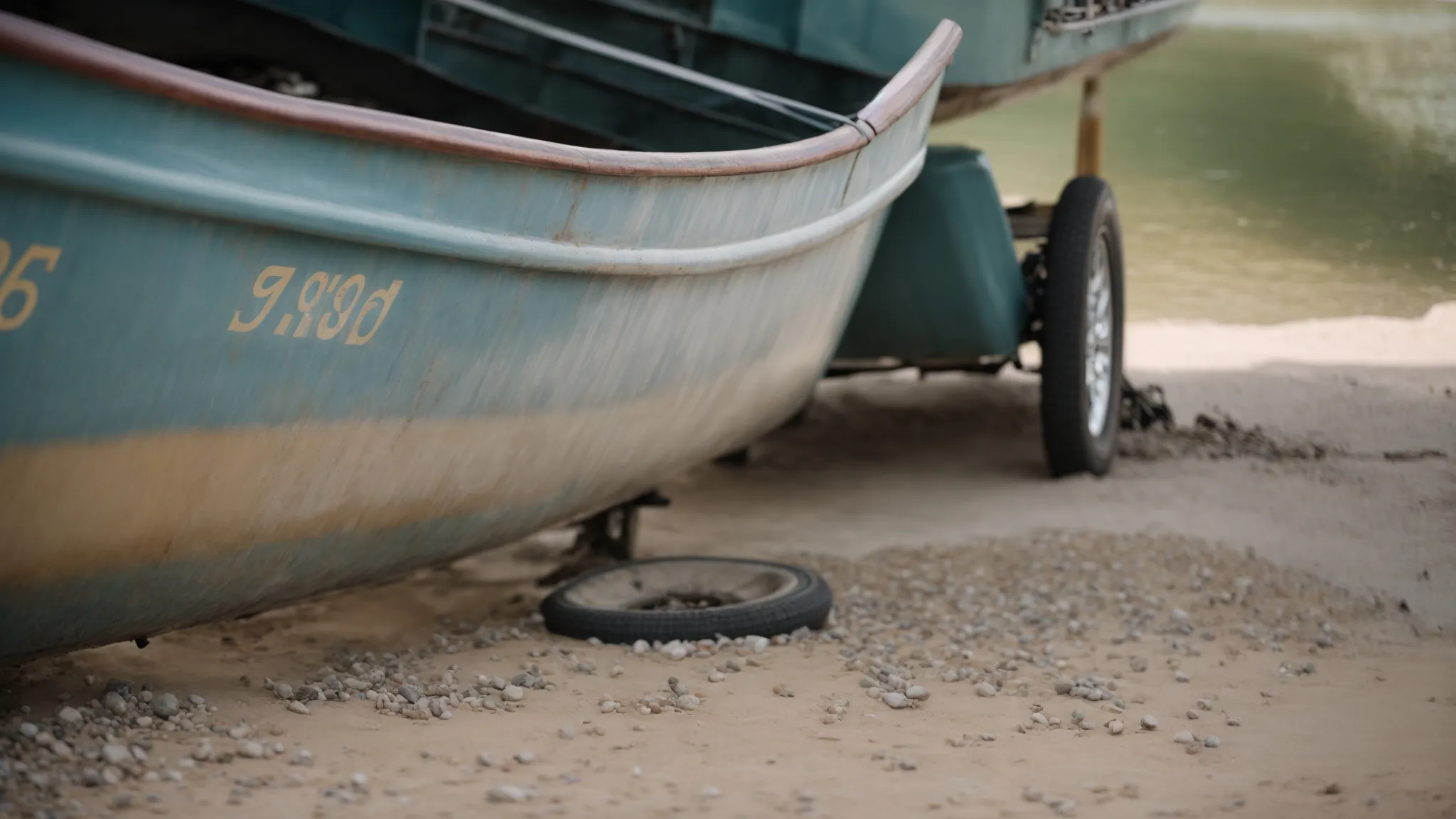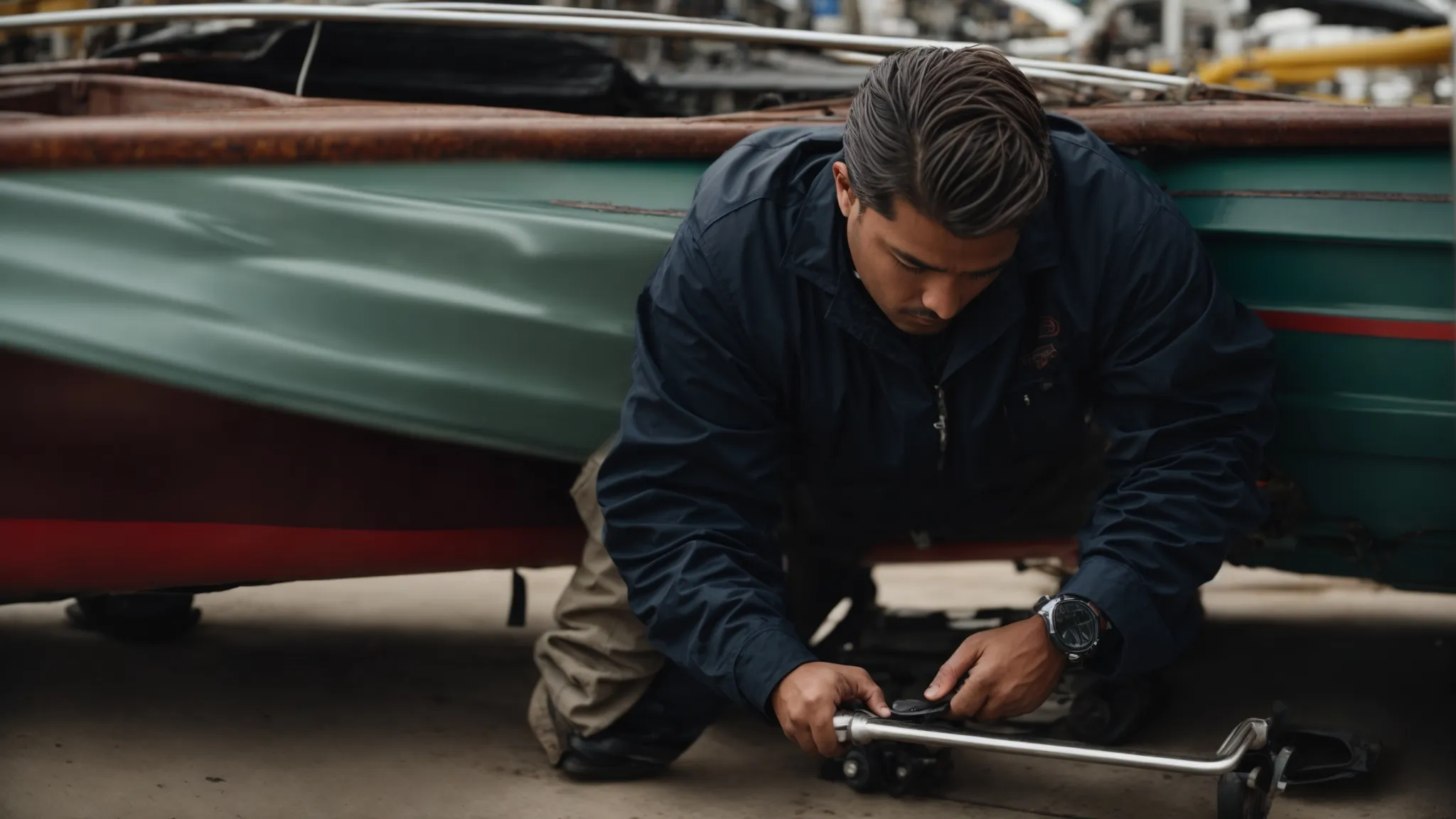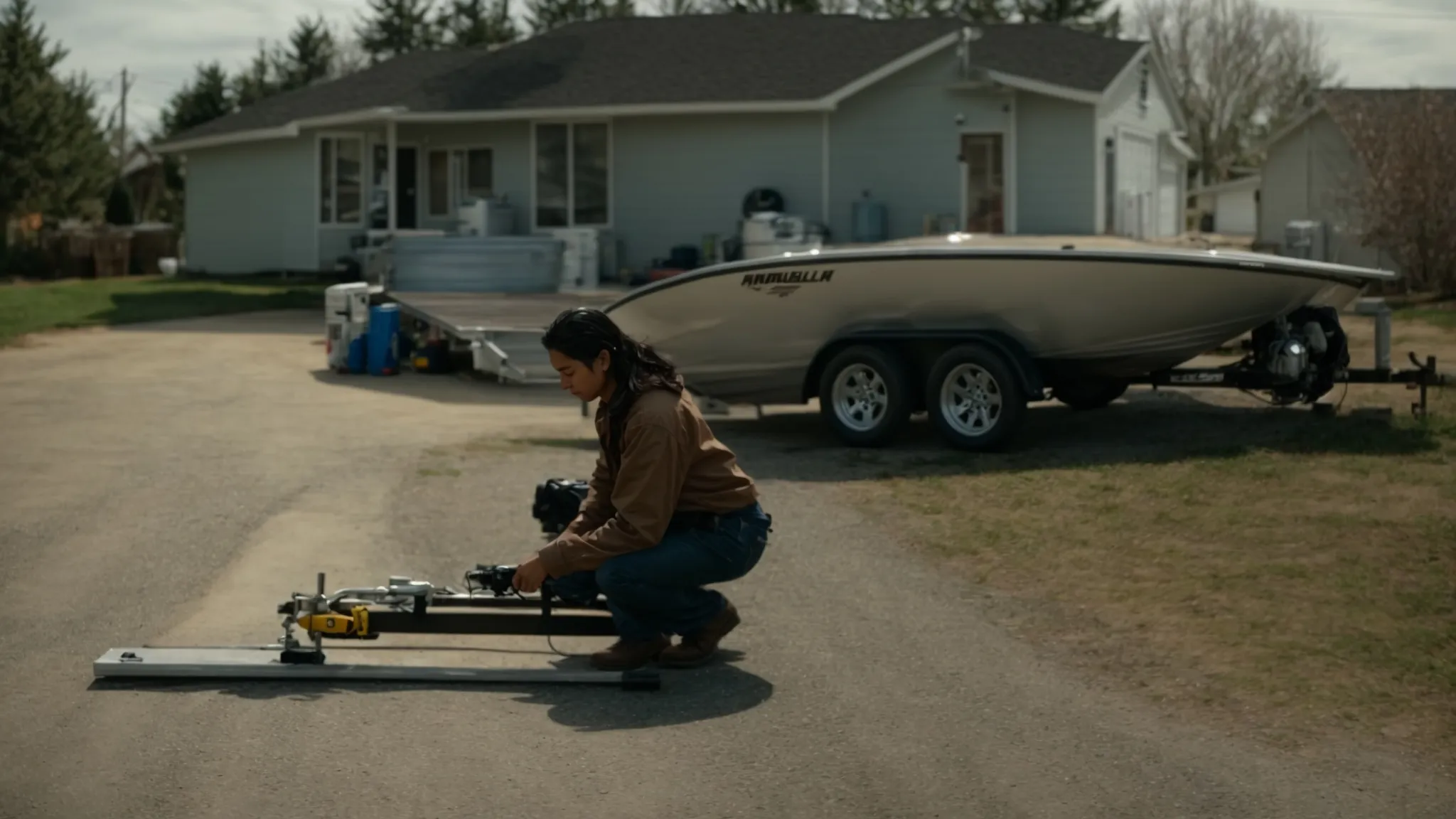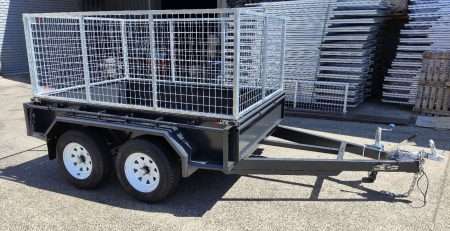
Enhance Your Boat Trailer’s Performance with Trailer Springs
Troubleshooting Common Issues With Boat Trailer Springs
Embarking on a journey across the azure waves, your boat in tow like a child clinging to its mother’s hand, demands not just courage but also unwavering trust in your equipment.
Among this equipment, the boat trailer springs stand as the silent sentinels, ensuring a smooth voyage from land to sea.
Yet, as with all things forged by human hands, these metallic compatriots are not immune to the ravages of time and use.
Bearing the brunt of your marine adventures, they can squeak, sag, or snap, turning every outing into a veritable odyssey.
Keep reading to unfurl the secrets of maintaining these crucial components, ensuring they remain steadfast companions on your seafaring escapades.
Key Takeaways
- Regular Inspections of Trailer Springs for Physical Deformations and Rust Are Vital to Maintaining Safety and Longevity
- Employing the Correct Tools and Safety Measures During Maintenance Ensures Both Efficiency and the Welfare of the Individual Undertaking the Repairs
- Establishing a Consistent Maintenance Schedule Is Essential for Preemptive Identification and Resolution of Potential Issues
- Correctly Selecting and Adjusting Trailer Springs According to Load Capacity Is Crucial for Optimal Performance and Durability
- Strategic Lubrication of Boat Trailer Springs Can Significantly Reduce Noise and Wear, Enhancing the Overall Trailer Experience
Identifying Signs of Wear in Boat Trailer Springs

Embarking on a journey across the tumultuous seas of troubleshooting boat trailer spring issues, one must first anchor themselves in the ability to recognize the telltale signs of wear and tear.
As a mariner would navigate through stormy waters with unyielding resolve, I find myself delving into the heart of boat trailer maintenance with the same level of determination.
The cornerstone of this quest lies in inspecting springs for physical deformations and unearthing the hidden, insidious threat of rust and corrosion.
These initial steps are akin to reading the sea’s surface for signs of what lies beneath; they are crucial indicators of the health and safety of your trailer’s undercarriage.
Let us set sail into the detailed examination of these components, for understanding these early warnings is the key to averting the potential calamities that poor maintenance can usher.
Inspect Springs for Physical Deformations
Upon the beckoning paths of routine maintenance, my gaze often falls upon the muscular arms of resilience that are the trailer springs, essential yet often overlooked. It’s here, beneath the belly of the boat trailer, that I seek out the nuanced whispers of wear – the bends, the cracks, and the subtle hints of distortion that speak volumes of the journeys traversed and the burdens borne. These deformations, subtle as they may be, act as a siren’s call, urging immediate attention lest we invite more formidable foes.
In a world where the integrity of a journey lays on the strength of its carriage, inspecting these springs for physical deformations becomes a tale of bridging trust between man and machine. As my hands glide over the cool metal of trailer axles and springs, feeling for aberrations as a map reader deciphers the contours of undiscovered lands, I am reminded that each imperfection is a narrative of past challenges. It is through these inspections that we ensure the tale of adventure continues unbridled, safeguarding both treasures and tales alike.
Look for Signs of Rust and Corrosion
As I delve deeper into the examination of boat trailer springs, my attention shifts to the silent yet relentless adversaries: rust and corrosion. These elements cloak themselves in the guise of inevitability, embedding their tendrils into the heart of galvanized boat trailer leaf springs, trailer leaf spring kits, and beyond, whispering promises of degradation and failure. It’s a battle not visible to the naked eye at first, yet it foretells a dire need for vigilance and intervention.
My quest to identify signs of wear doesn’t stop at mere physical deformations. It extends into the realm of chemical warfare waged by nature against the crafted strength of trailer axle springs and leaf springs for boat trailers. The presence of rust and corrosion serves as a harsh reminder of the impermanence of even the most stalwart materials. It’s the red or brown plague that, once spotted, demands decisive action to prevent the structural integrity of our noble vessels from being compromised.
Spotting the battle scars on your boat trailer springs is just the beginning of the adventure. Now, let’s embark on the thrilling journey of mending a broken leaf in your trailer spring assembly!
Fixing a Broken Leaf in Your Trailer Spring Assembly

As the captain of my own maintenance odyssey, facing the daunting task of fixing a broken leaf in the trailer spring assembly, I’m acutely aware that meticulous preparation paves the way to smooth sailing.
It begins with ensuring the boat trailer is safely cradled in the arms of security, free from the tremors of unexpected movements.
With the stage set and the spotlight focused, the next act involves the careful removal of the damaged leaf, a procedure swaddled in layers of safety to protect not just myself, but the integrity of our trusty vessel.
This journey through the springs’ rehabilitation is not for the faint-hearted, but rather for those armed with patience and precision, ready to restore harmony to the mechanical symphony that plays beneath our boats.
Ensure the Boat Trailer Is Securely Supported
Embarking on the mission to fix a broken leaf in the trailer spring assembly, the paramount step I adhere to is ensuring the boat trailer is securely supported. Like the foundation of a lighthouse standing steadfast against the fury of the ocean, a stable base prevents any unforeseen shifts that could jeopardize the safety of the repair process.
The balance and stability of the terrain underneath the support mechanisms are as crucial as the keel to a ship; they guarantee that the repair voyage does not encounter unnecessary turbulence. In my practice, ensuring this aspect of the process is akin to charting a course with precision, acknowledging that the success of my endeavor significantly hinges on the steadfast support of the vessel under repair.
Remove the Damaged Leaf Following Safety Procedures
Stepping into the heart of the matter with a craftsman’s care, I approach the task of removing the damaged leaf with an unwavering commitment to safety. Gloves on and tools in hand, I enter this surgical procedure on the boat trailer’s spring assembly, mindful of the potential hazards that lie in wait.
My methodical removal of the damaged leaf from the trailer spring assembly is guided by a deep-seated understanding of the delicate balance between force and finesse. With each turn of the wrench, I hold the well-being of both the machinery and myself in high regard, ensuring that every action is a step towards restoration rather than further distress.
Now that we’ve tackled the challenge of a broken leaf in your trailer spring assembly, it’s time to set our sights on the next adventure. Adjusting the tension on your boat trailer springs properly promises to be an enlightening journey, full of twists and turns.
Adjusting Tension on Boat Trailer Springs Properly

Navigating the seas of boat trailer maintenance, I’ve come to a pivotal moment where adjusting the tension on boat trailer springs demands my undivided attention.
It’s a delicate dance, one that requires a nuanced understanding of the mechanical ballet that unfolds beneath our trusty trailers.
To anchor our efforts in precision, we must embark on measuring current tension levels with meticulous accuracy, ensuring we neither over-tighten nor leave our springs languishing in laxness.
Equally imperative is arming ourselves with the appropriate tools, those faithful companions in our quest to adjust spring tension safely, safeguarding our vessel’s journey from the unforeseen tempests of the road.
This phase of our journey is not just about tightening bolts; it’s about charting a course that promises balance and longevity for our nautical carriers.
Measure Current Tension Levels for Accuracy
In the labyrinth of boat trailer spring adjustments, measuring current tension levels stands as my beacon of accuracy. This crucial step, akin to navigating by the stars, allows me to gauge the precise state of tension, ensuring that the adjustments made are neither too taut nor too slack, but perfectly tailored to the trailer’s needs.
Armed with a reliable tension gauge, I embark on this meticulous task, fully aware that precision here is paramount. This instrument becomes an extension of my senses, translating the unseen forces at play within the springs into a language of numbers and measurements that I can understand and act upon with confidence.
Use Appropriate Tools to Adjust Spring Tension Safely
In the endeavor of adjusting the tension on boat trailer springs correctly, employing the appropriate tools is not just a matter of efficiency; it’s a significant safety measure. By using the correct tools, we minimize the risks associated with this maintenance task, protecting ourselves and the integrity of the boat trailer.
| Tool | Use |
|---|---|
| Tension Gauge | Measuring spring tension accurately |
| Wrench Set | Adjusting nuts and bolts to the correct tightness |
| Safety Glasses | Protecting eyes from potential flying debris |
My approach marries precision with precaution: selecting tools that not only fit the task at hand but also ensure that any adjustments to the spring tension are done within the safe confines of recommended practices. This meticulous selection process underscores my pledge to uphold the highest standards of maintenance and safety.
Mastering the art of tension adjustment marks just the beginning of our journey. Let’s pivot towards ensuring these stalwarts of stability keep holding the line through vigilant maintenance.
Preventing Common Spring Failures With Routine Checks

Steering our journey into the calm waters of preventative care, I pivot towards establishing a citadel against the unforeseen storms of spring failures with routine checks.
This segment of our voyage underlines the essence of drawing up a reliable maintenance schedule and embarking on thorough inspections with a keen eye on spring integrity.
These practices are not merely routines; they are the guardians of our boat trailer’s longevity.
Through these actions, we fortify our trailers against the caprices of time and use, ensuring they continue to bear the weight of our adventures with unwavering strength.
Establish a Regular Maintenance Schedule
Charting a course for maintaining the robustness of boat trailer springs, establishing a regular maintenance schedule emerges as my lighthouse, guiding me toward ensuring the longevity and reliability of these vital components. It’s akin to plotting a navigational chart for the journeys ahead, where each check is a waypoint ensuring a smoother sail, free from the turbulent surprises of wear and tear.
My commitment to this regimen transforms into a ritual of inspection and care, a cadence that rhythmically aligns with the changing seasons and the accumulation of miles. In this routine, I find not only the preservation of mechanical integrity but also peace of mind, knowing that each venture into the wild blue yonder is underpinned by meticulous preparation and forethought.
Conduct Thorough Inspections Focusing on Spring Integrity
Embarking on the vigilant task of inspecting the boat trailer springs, my attention zeroes in on their structural integrity. It’s a process likened to the careful examination of a ship’s hull before setting sail, where every dip and curve is scrutinized for breach or fatigue, ensuring that they stand robust against the forces they’re destined to meet.
In this meticulous examination, my gaze is sharp, and my hands are gentle yet firm, as I chart the condition of each spring. Recognizing that the health of these springs is paramount to a voyage’s success, I seek out even the most minor anomalies. It’s a commitment to precision that promises safe passage through the relentless tides of travel and time.
As we navigate away from the realm of routine maintenance, an exhilarating upgrade awaits on the horizon. Elevating your boat trailer to withstand the rigors of heavy-duty use begins with a foundational leap – upgrading your boat trailer springs.
Upgrading Your Boat Trailer Springs for Heavy-Duty Use

Embarking on the journey of upgrading boat trailer springs for heavy-duty use, I find myself at the helm, navigating through the considerations of assessing current and imminent loading needs.
This pivotal moment demands that I scrutinize both the harbored cargo of today and the aspirations of tomorrow’s hauls.
The selection of the right type of springs, those muscular arms of resilience tailored to the precise load capacity, becomes a testament to the foresight employed in preparing for the tides of demand.
It’s a venture where armed with knowledge and insight, I aim to not only meet but exceed the challenges presented by enhanced loading requirements.
Assess Your Current and Future Loading Needs
Standing at the crossroads of utility and necessity, I find assessing current and future loading needs an imperative step in upgrading boat trailer springs for heavy-duty use. It’s a delicate balance, contemplating what the trailer currently endures versus the potential growth or change in what it will need to support: a dance of anticipation and preparation.
Understanding the weight each journey demands allows me to sketch a blueprint for resilience. This assessment is not just about acknowledging the present but forecasting the future with an architect’s precision. Here’s how I craft this transition into heavier duty readiness:
- Evaluating the current load types and weights my trailer habitually carries.
- Anticipating any foreseeable increase in load size or weight, including potential new types of cargo.
- Selecting trailer springs designed to not only meet but exceed these identified needs, ensuring longevity and reliability.
Choose the Right Type of Springs Based on Load Capacity
Embarking upon the endeavor of selecting the right type of springs based on load capacity is akin to choosing the best sails for a ship: it dictates the stability and endurance of your journey. With the right springs, tailored to the weight they’ll bear, you ensure that your vessel is equipped to navigate even the heaviest of seas with grace and durability.
The exercise of choosing springs isn’t just a matter of matching numbers. It’s a meticulous balancing act: analyzing the cargo, understanding the journey, and foreseeing the challenges. This three-step process is the compass by which I navigate:
- Analyzing the typical load my trailer carries to gauge the baseline requirement.
- Understanding the dynamics of the cargo, considering both weight distribution and potential shifts during transit.
- Foreseeing the terrain and environmental challenges that my trailer will face, thus choosing springs that are not merely sufficient but are robust for the unexpected.
Embarking on the journey to fortify your boat trailer springs sets the stage for smooth sailing. Yet, as the tides turn, eerie creaks and groans emerge, beckoning us to unearth the mysteries behind noisy or squeaky boat trailer springs.
Troubleshooting Noisy or Squeaky Boat Trailer Springs

Amid the symphony of the sea and the rhythm of rolling waves, a dissonant note strikes from beneath: the irksome clamor of noisy or squeaky boat trailer springs.
This unwelcome soundtrack to a would-be serene venture demands immediate attention, inviting me to embark on a detective’s quest to silence the cacophony.
The preliminary step in this endeavor pivots around a meticulous visual inspection, a methodical survey beneath the trailer’s frame to catch the whisper of wear or the shadow of misalignment.
With the culprit’s echo traced to its source, the next course charts a path through strategic lubrication, a delicate dance of applying the elixir where metal meets metal, reducing friction and restoring quietude.
This procedural tandem – inspect and lubricate – stands as my steadfast allies in reclaiming the serenity of my maritime journey.
Identify the Source of Noise Through Visual Inspection
Initiating my investigation into the chorus of creaks and groans from beneath the boat trailer, I approached with a mindset akin to that of an explorer charting unknown territories. My first step: a thorough visual inspection, where every inch of the boat trailer springs becomes a chapter in a book, each telling its own tale of strain or resilience.
| Step | Action | Discovery Potential |
|---|---|---|
| 1 | Examine for visible rust or corrosion | Indications of decay that can lead to noise |
| 2 | Check for misaligned components | Potential source of friction and noise |
| 3 | Look for signs of excessive wear or cracks | Structural weaknesses contributing to squeaks |
Every mark, every subtle deviation from the norm, served as a valuable clue. By aligning my senses with the task, I sought out disparities: signs of abnormal wear, rust patches blooming like unwelcome weeds, or a misalignment as minute as it might be. Each of these findings could be the harbinger of the invasive noise, guiding my next steps towards a remedy.
Apply Lubrication to Reduce Friction and Noise Effectively
Setting sail on the voyage to tranquility, my journey towards silencing the discordant symphony of squeaky boat trailer springs leads me to the shores of strategic lubrication. In this delicate operation, it’s not just about applying any lubricant; it’s about choosing the right elixir. A grease that’s both tenacious and apt for the maritime environment, capable of standing against both salt air and tempests, becomes my chosen weapon in this battle against friction and noise.
With precision, I navigate the narrow inlets and crags where metal meets metal, my hands steady as I apply the lubricant. This isn’t merely a task; it’s a rite of passage that each trailer must undergo to ensure its whispers remain hushed beneath the hull’s shadow. Each drop of lubricant acts as a peacemaker, smoothing over the rough conversations between the parts, restoring peace and quiet to my nautical endeavors.
Conclusion
Troubleshooting common issues with boat trailer springs is pivotal for ensuring the long-term health and safety of your maritime adventures.
By vigilantly inspecting for physical deformations and signs of rust and corrosion, you can identify early warnings of wear and tear, preventing potential failures on the road.
Fixing broken leaves and adjusting tension properly not only restore functionality but also extend the lifespan of your trailer’s underpinning components.
Regular maintenance checks and considering upgrades for heavy-duty use reflect proactive stewardship, ensuring your trailer can sustain the demands of varied cargoes and trips.
Addressing noises through meticulous inspection and strategic lubrication prevents minor annoyances from escalating into major concerns.
In sum, diligent care and timely troubleshooting of boat trailer springs are essential practices that safeguard your nautical journey, ensuring smooth sailing both on and off the water.
Author

How to Mount a Spare Tire on Your Trailer: A Simple Step-by-Step Guide
Trailer service centers receive over 1 million phone calls and 1.3 million emails each year about trailer maintenance problems....

How to Fix RV Roof Leaks: Simple Roof Leak Detection Guide for Beginners
Did you know DIY RV roof repairs can cost under $50? But undetected leaks could lead to substantially higher repair...

Starting a Food Truck Business in Australia: From Trailer Selection to Launch
The Australian mobile food market has evolved into a billion-dollar industry. This makes a food truck...
